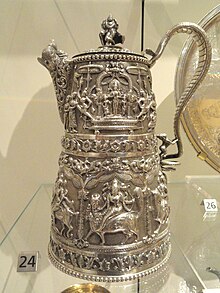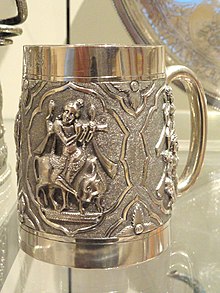
A silversmith is a metalworker who crafts objects from silver. The terms silversmith and goldsmith are not exact synonyms, as the techniques, training, history, and guilds are largely the same but differed in that the end product may vary greatly.

Raja Ravi Varma was an Indian painter and artist. His works are one of the best examples of the fusion of European academic art with a purely Indian sensibility and iconography. Especially, he was notable for making affordable lithographs of his paintings available to the public, which greatly enhanced his reach and influence as a painter and public figure. His lithographs increased the involvement of common people with fine arts and defined artistic tastes among the common people. Furthermore, his religious depictions of Hindu deities and works from Indian epic poetry and Puranas have received profound acclaim. He was part of the royal family of erstwhile Parappanad, Malappuram district.

The Wadiyar dynasty, also referred to as the Wadiyars of Mysore, is a late-medieval Indian royal family of former maharajas of Mysore from the Urs clan originally based in Mysore city.
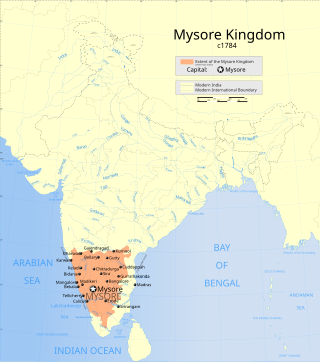
The Kingdom of Mysore was a geopolitical realm in southern India founded in around 1399 in the vicinity of the modern-day city of Mysore and prevailed until 1950. The territorial boundaries and the form of government transmuted substantially throughout the kingdom's lifetime. While originally a feudal vassal under the Vijayanagara Empire, it became a princely state in British India from 1799 to 1947, marked in-between by major political changes.
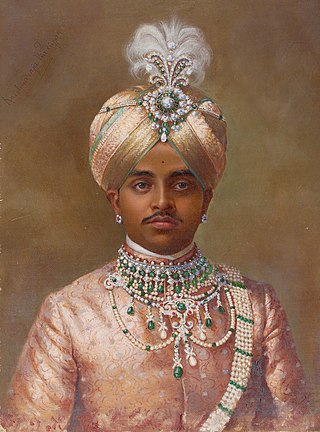
Krishnaraja Wadiyar IV (4 June 1884 – 3 August 1940) was the twenty-fourth Maharaja of Mysore, reigning from 1902 until his death in 1940.

Robert Radford Welch MBE, RDI, was an English designer and silversmith.

The Padmanabhaswamy Temple is a Hindu temple dedicated to Vishnu in Thiruvananthapuram, the capital of the state of Kerala, India. It is one of the 108 Divya Desams which are considered the sacred abodes of Vishnu in the Sri Vaishnava tradition. The name of the city of 'Thiruvananthapuram' in Malayalam and Tamil translates to "The City of Ananta". The temple is built in an intricate fusion of the Kerala style and the Dravidian style of architecture, featuring high walls, and a 16th-century gopuram. While as per some traditions the Ananthapura temple in Kumbla in Kasaragod district in Kerala is considered as the original spiritual seat of the deity ("Mulasthanam"), architecturally to some extent, the temple is a replica of the Adikesava Perumal temple in Thiruvattar in Kanyakumari district in Tamil Nadu. It is widely considered the world's richest Hindu temple.

Garrard & Co. Limited designs and manufactures luxury jewellery and silver. George Wickes founded Garrard in London in 1735 and the brand is headquartered at Albemarle Street in Mayfair, London. Garrard also has a presence in a number of other locations globally. Garrard was the first official and most notably important Crown Jeweller of the United Kingdom having supplied jewels for Queen Victoria, and was charged with the upkeep of the British Crown Jewels, from 1843 to 2007, and was responsible for the creation of many tiaras and jewels still worn by the British royal family today. As well as jewellery, Garrard is known for having created some of the world's most illustrious sporting trophies, including the America's Cup, the ICC Cricket World Cup Trophy and a number of trophies for Royal Ascot in its role as Official Trophies and Silverware Supplier, which originally dates back to the first Gold Cup in 1842.

Higginbotham's is an Indian bookstore chain and publisher based in the city of Chennai. The company's first bookstore at Mount Road, Chennai is India's oldest bookshop still in existence, founded in 1844. The company's second bookstore in Bangalore, located at M. G. Road, opened in 1905 and is the oldest existing bookstore in the city. Since 1949, Higginbotham's has been owned by the Amalgamations Group. In the late 19th century, the company published books under the name Higginbotham & Co.

Hester Bateman was an English silversmith, renowned for her high quality flatware and ornamental silverware. A craftswoman working within the family business, she was succeeded in turn by her sons, daughter-in-law, grandson and great-grandson. The Bateman family silversmithing company lasted until the middle of the nineteenth century.

Sri Radha Krishna-Chandra Temple is one of the largest Krishna-Hindu temples in the world. It is situated in Bangalore in the Indian state of Karnataka. The temple is dedicated to Hindu deities Radha Krishna and propagates monotheism as mentioned in Chandogya Upanishad.
Rao Bahadur M. S. Nagappa was an Indian sculptor who designed statues and monuments in British India. In 1935, Nagappa was appointed official sculptor to the British Crown by George V.

P.Orr & Sons, founded in 1846, is a chain of stores that sells watches and clocks based in the city of Chennai in India. It used to primarily make clocks, and at the end of the 19th century, various objects in the style known as Swami silver, with European shapes but Hindu decoration.
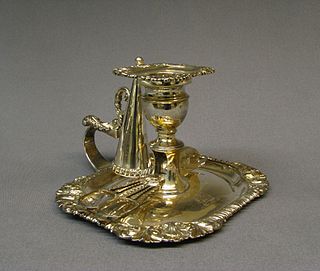
Rebecca Emes was an English silversmith, known for her household silverware.

The Statue of Queen Victoria, Bangalore, is located at Queen's Park, next to Cubbon Park, Bangalore Cantonment, at the junction of 3 roads, at the border between the Cantonment and the Bangalore Pete. The statue was unveiled on 5 February 1906 by the then Prince of Wales, George Frederick Ernest Albert. The statue was raised out of funds raised by the residents of the Bangalore Civil and Military Station and contributions made by Krishna Raja Wadiyar IV, the Maharaja of Mysore. This Statue of Queen Victoria is one of the five of the original 50 statues of Queen Victoria which were installed in British India, to still stand at its original location. The statue has blossoms of jacaranda falling around. On the other end of Queen's Park is the Statue of King Edward VII.

Chinese export silver is silverware made in China for export, mainly to Europe. It is analogous to the much larger production of Chinese export porcelain, but unlike this remained largely confined to ornamental objects rather than practical tableware. In the eighteenth and nineteenth centuries, through the Chinese Canton System and after that, the opium war, the Treaty of Nanking and Treaty of Tientsin, Qing dynasty China became a major exporter for fine Chinese goods such as tea, spices and porcelain etc. to Europe, Germany, France, Russia and America and north Africa. The Treaty trading ports were further extended throughout the entire Qing Dynasty's land.

Black, Starr & Frost, previously known as Marquand and Co, is an American jewelry company. Founded in 1810 as Marquand and Co., the company is the oldest continuously operating jewelry firm in the United States. The company has acted as a retailer, rather than manufacturer, for most of its history.
Arni Jagir was a Jagir (estate) and a permanently settled zamindari estate that existed in the North Arcot subdivision of the North Arcot district of the erstwhile Madras Presidency in British India from 1638 to 1948.
Cooke & Kelvey was founded in 1858 by Robert Thomas Cooke and Charles Kelvey. They were Kolkata-based clock-makers, silversmiths, jewelers working during the later period of British India. Notable Cooke and Kelvey clocks include those in the Salar Jung Museum in Hyderabad, the Bhim Chandra Nag sweet shop in Kolkata, and the Fairlie Warehouse in Kolkata. They remain silversmiths with showroom in New Delhi. Also they are the first and oldest appointed Rolex and Tudor retailers in India since 1946.

John Chandler Moore was an American silversmith, active in New York City. While initially working for Marquand and Co., he worked exclusively for Tiffany & Co. after 1851. His son, Edward Chandler Moore, was in charge of designing and manufacturing silverware at Tiffany.
